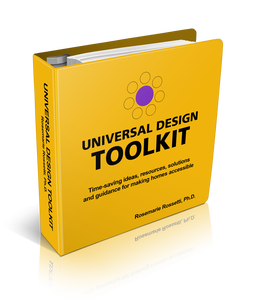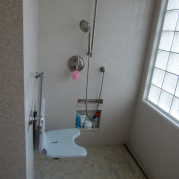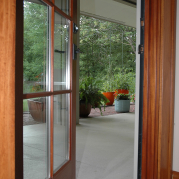How to Talk with Clients: Remodeling for Retirement
By: Rosemarie Rossetti, Ph.D.
How do you talk about aging when you are interviewing a new client about their remodeling project?
In a recent interview with Stephanie Loucka, Director of the Ohio Department of Aging, she said, “People just don’t like talking about aging. Builders and remodelers need to have a conversation with their clients to explain the value proposition of making an investment now in their homes to enable them to live in their own homes longer.”

When my husband and I built our home, the Universal Design Living Laboratory, a national demonstration home and garden in Columbus, Ohio we built it with universal design and accessible features. We intend to live in this home for our lifetime.
An Ever Growing Opportunity
The American population is graying. One in three Americans is now 50 or older — by 2030, one in five will be 65+. The number of people 65 and older in the United States is expected to increase to 55 million in 2020; to some 70 million by 2030, and to 88.5 million — or 20 percent of the population — in 2050. (U.S. Census Bureau, 2010)
The Centers for Disease Control and Prevention estimated that one in five Americans—about 53 million people has a disability of some kind. The American Community Survey in the 2014 indicated that 36% of the U.S. population 65 or older has a disability. Additionally, 23% had difficulty walking or climbing stairs.
33 million Americans have a disability that makes it difficult for them to carry out daily activities.
2.2 million people in the United States depend on a wheelchair for day-to-day tasks and mobility.
6.5 million people use a cane, a walker, or crutches to assist with their mobility.
An AARP study in 2014 indicated 87 percent of adults age 65+ want to stay in their current home and community as they age. Among people age 50 to 64, 71 percent of people want to age in place. The United States of Aging survey in 2012 showed that approximately 90 percent of seniors intend to continue living in their current homes for the next five to 10 years.
Remodelers need to incorporate ways for people of all ages and abilities to live in a home safely, independently and comfortably. There are forward-thinking ways to remodel.
Design for All Abilities
There are many terms remodelers read about and use when communicating about homes that enable families to live in their homes during their retirement. The terms include: universal design, accessible design, aging in place, living in place, age friendly, and forever home.
Aging in place is the ability to live in one’s own home and community safely, independently, and comfortably, regardless of age, income or ability level.
The definition of universal design is the design of products and environments to be usable by all people, to the greatest extent possible, without the need for adaptation or specialized design. Universal design should be transparent design. Universal design is an approach to planning that embraces diversity and inclusion by providing for equitable use while promoting efficiency, flexibility and sustainability.
Universal design takes as many needs as possible into consideration in the design process. The broadest spectrum of users is considered. It traditionally focuses on creating non-stigmatizing, equitable designs. Based on the premise that the environment can level the playing field for people with disabilities, it provides a broader, yet complementary approach to design. It is age and content appropriate, aesthetically pleasing, affordable, and has a broad market appeal.



Environmental factors in homes can be disabling or enabling. Remodelers need to design to human strengths, while accommodating for individual weaknesses and limitations. Design to work with, support, and enhance human functioning.
Insightful discussion
When discussing a remodeling project with a prospect or client, point out that according to research by Genworth in 2016, the average cost to live at an independent living facility is $43,536 per year.
To get a more accurate assessment of the true costs, factor in tangibles like the costs of selling a home and moving expenses. Emphasize that there are also intangible downsides to moving, such as the hassle of clearing out clutter, selling furniture, and the disruption of social networks in the neighborhood.
Then compare that cost to the investment they can make to remodel their home to enable them to stay in their home longer.
Here are questions to ask your prospects and clients to help you have a conversation about their current and future needs.
- Who will be living in the house with you? (spouse, partner, parents, children, grandparents or grandchildren)
- Does someone in your home have special needs due to physical, sensory and/or medical impairments and will need selected features in the home to accommodate them?
- What health limitations do you or others you live with have that may impact the ease of living in your home?
- Do you or anyone you live with have difficulty entering or exiting your home, moving from room to room, or using the kitchen or bathroom?
- Are some activities more difficult now than they were in the past?
- Do you have health conditions that may impact your ability to use certain spaces or rooms in your home?
- What else about your health and prognosis should I know to do a good job on this project?
- Is it important to you to have a full bathroom and bedroom on the first floor?
- Do you have family members come to visit? Stay overnight? Do any have a disability?
- How long do you want to live here? Do you plan to live in your home through retirement?
ABOUT THE AUTHOR

Rosemarie Rossetti, Ph.D., consults with remodelers, builders, architects, designers, and consumers that want to create inspired and livable homes. She is an internationally known speaker, consultant, and author (RosemarieSpeaks.com). Her newest resource, the Universal Design Toolkit, is an illustrated 200-page e-book with online videos and webinars.
| 7/31/2017 5:33:39 AM |
61 comments